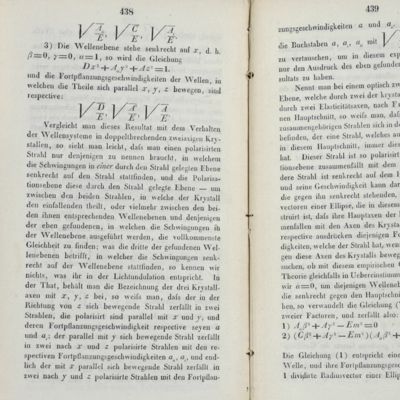Neumann, F. E.
Theorie der doppelten Strahlenbrechung, abgeleitet aus den Gleichungen der Mechanik.
Leipzig, Johann Ambrosius Barth, 1832. 8vo (18.8 x 11.9 cm). 37 pp. [numbered 418-454]. Grained quarter cloth over marbled boards.
Offprint. Important contribution to the science of optics, by the German physicist, mathematician, mineralogist and Copley Medal laureate Franz Ernst Neumann (1798-1895), and published in the famous Annalen der Physik, Volume 101(7). "In his article Neumann reported obtaining a wave surface identical with that determined earlier by Augustin Cauchy, and he succeeded in deducing laws of double refraction agreeing with those of Fresnel except in the case of biaxial crystals"(DSB). "Devoting himself.. to optics, he produced memoirs which earned him a high place among early searchers of a true dynamical theory of light. In 1832, by the aid of a particular hypothesis as to the constitution of the ether, he reached by a rigorous dynamical calculation results agreeing with those obtained by Augustin Louis Cauchy, and succeeded in deducing laws of double refraction closely resembling those of Augustin-Jean Fresnel. In studying double refraction, with his deduction of the elastic constants (on which the optical properties depend) Neumann employed the assumption that the symmetry of the elastic behavior of a crystal was equal to that of its form. In other words, he assumed that the magnitudes of the components of a physical property in symmetric positions are equivalent. This assumption substantially reduced the number of independent constants and greatly simplified the elastic equations" (Wikipedia). Offprint, with p. 417, which precedes Naumann's paper, left blank. Bound in a somewhat later binding. Provenance: Stamps of the Bibliothek der Bergschule in Bochum on the front pastedown, first blank, the top margin of the first printed page, and below the last text on p. 454. Some foxing on the first and last leaves, otherwise a very good, complete copy. DSB volume X, pp. 26-29.


![image for S. Anthonius [Saint Anthony] tormented by demons. [After Martin Schongauer and Raphaël De Mey].](https://www.schierenberg.nl/media/cache/product_thumb/75809/75809_x.jpg)



